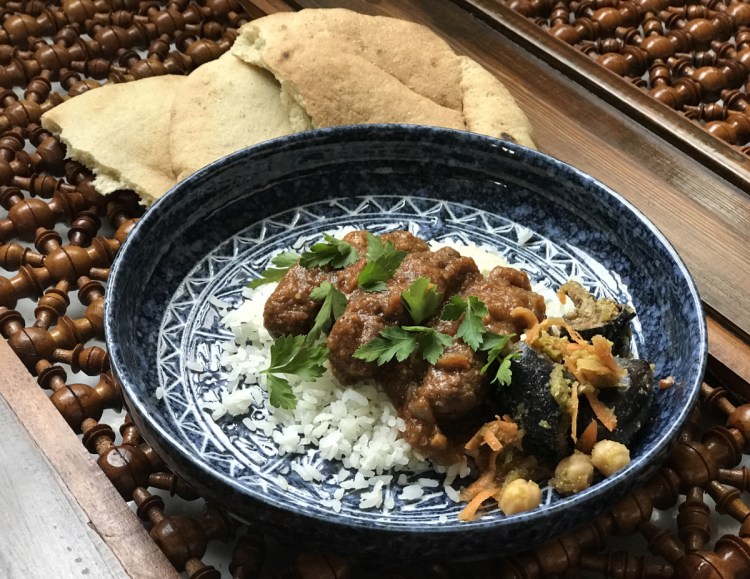All local food is geographically relative, of course. But cultural considerations also apply when you’re traveling.
In Cairo, Egypt, you can see sheep and goats raised further afield – likely in the fertile Delta region north of the city where the Nile splits in two – grazing on piles of roadside garbage as they await their turn at the halal slaughterhouse. But camels sold at Birqash Camel Market located 35 kilometers northwest of this bustling city eat only grass and hay until they are slaughtered and distributed to neighborhood market stands all around Cairo.
The morning after I arrived in Egypt to visit friends serving in the diplomatic corps, we piled into an armored car, and took the 45-minute ride to the camel market from Maadi, the Cairo neighborhood where they live. We’d dressed conservatively as we’d likely be the only women there, spare the local tea lady, and brought scarves to protect our faces in case a sandstorm kicked up. The road was dusty, bumpy, and peppered with small villages, many featuring an open-air shop with a hindquarter of a camel hanging in the wind for all to see.

Fatima demonstrated for American visitors to Eqypt her family recipe for the kofta she serves a couple of times a month. Photos by Christine Burns Rudalevige
While some camels raised for their meat come from the Sinai Peninsula, most have walked with their herders the Forty Days Road from western Sudan to Abu Simbel and are then hobbled and trucked first to Daraw in Upper Egypt and then to Birqash, the end of the line for these animals.
The camel market is frenetic. Hundreds of towering camels mill around, some bolting because of the stress of it all while their tenders try to keep them in line with bamboo sticks and bursts of verbal commands. The air buzzes with the electricity of cash-only commerce.
You don’t regularly see camel meat featured on restaurant menus here, but it is on routine rotation on Egyptian family tables. My host called an acquaintance she knew could tell us where in Cairo we could find some to cook ourselves. Alaa el Masry informed us that he’d collect us at noon the next day and we’d shop with him and his wife, Fatima, at the very best place for buying camel meat. Fatima would teach us how to make the kofta dish she serves a couple of times a month.
In a market lining the back streets in a part of Maadi where my friend had never previously ventured, Alaa and Fatima led us to the stall owned by Ramy Hassan, a young man who sells just one thing: minced camel for making kofta, a highly flavored tubular meatball. Alla requested a half-kilo for us in Egyptian Arabic, as we tried to nonverbally chat with the smiling burqa-clad women also waiting for camel kofta mince.
Ramy carved the red meat from one of the hanging camel quarters and wielded his large curved knife to hack off enough fat from the other to effectively flavor and moisten the meat and sent both through a large grinder.

Fatima rolls the kofta into the shape of breakfast sausages. Photo by Christine Burns Rudalevige
He passed the coarse mince to a colleague, who added ground uncooked rice, parsley, dill, cilantro, salt and pepper. He, in turn, passed the mixture several times through another machine to make a bright green paste. Fatima graciously took the kofta mix, and us, into her kitchen, located in a large apartment building about a 20-minute drive through Cairo traffic.
Fatima’s kitchen is set up in a triangle configuration with refrigerator, sink and propane gas stove at each point for the cook’s convenience. Counter space is plentiful, and a small work table sits under a sunny window through which she can point to the apartments where both of her sons and their families live within shouting distance. But she showed us how to roll kofta into breakfast sausage shapes in her living room, where she also served us tea and fruit as honored guests.
While kofta are generally skewered and grilled, Fatima fries hers first in vegetable oil and then simmers them in a pureed tomato sauce spiced with a Baharat spice blend plus extra cayenne, cinnamon, coriander, cumin and curry in ratios that her family knows as her own. Her son Moataz translated what Fatima and I, though fellow cooks, could not discern about each other. When Fatima asked through him if I liked spice and I replied in the affirmative, his response was, “Oh bless you!” We sat in her living room, watching old Egyptian movies and leafing through family photo albums as we waited for the kofta to be just the right amount of tender.
It was my desire to experience local flavor that drove me to taste camel meat in the first place, but it was Fatima’s generosity and cooking skill that enabled me to enjoy it.
Christine Burns Rudalevige is a food writer, recipe developer and tester and cooking teacher in Brunswick, and the author of “Green Plate Special,” a cookbook from Islandport based on these columns. She can be contacted at:
cburns1227@gmail.com
Send questions/comments to the editors.



Success. Please wait for the page to reload. If the page does not reload within 5 seconds, please refresh the page.
Enter your email and password to access comments.
Hi, to comment on stories you must . This profile is in addition to your subscription and website login.
Already have a commenting profile? .
Invalid username/password.
Please check your email to confirm and complete your registration.
Only subscribers are eligible to post comments. Please subscribe or login first for digital access. Here’s why.
Use the form below to reset your password. When you've submitted your account email, we will send an email with a reset code.